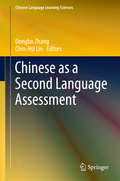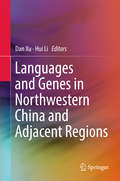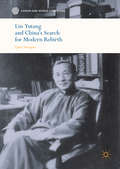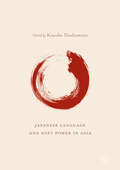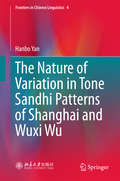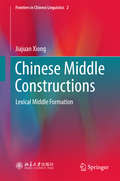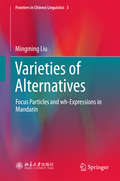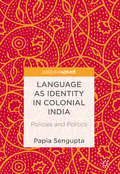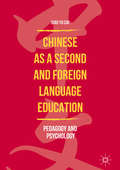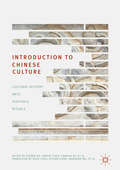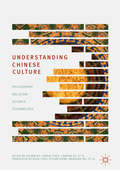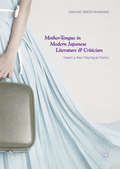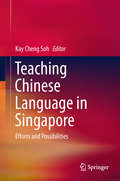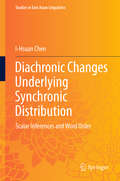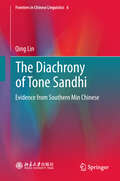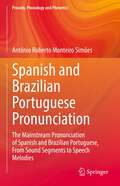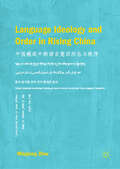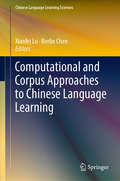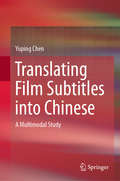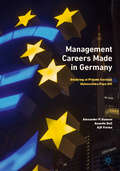- Table View
- List View
Chinese as a Second Language Assessment (Chinese Language Learning Sciences)
by Dongbo Zhang Chin-Hsi LinThis book brings together 13 original research papers that address emerging issues in the assessment of Chinese as a Second Language (CSL) in five major areas, including standards in CSL assessment; development of CSL tests; assessment of diverse knowledge and skills; computer-supported assessment; and CSL assessment in relation to instruction and teachers’ assessment competence. It goes beyond the psychometric testing of Chinese and provides cutting-edge examinations of the interfaces of assessment with sociology of language, acquisition, pedagogy, and modern technologies, as well as teacher education. Given its unique features and broad range of topics, the book offers an intriguing and valuable resource, not only for scholars and researchers but also teacher educators and assessment practitioners who are directly or indirectly involved in CSL assessment.
Languages and Genes in Northwestern China and Adjacent Regions
by Dan Xu Hui LiThis book presents an investigation of language contact, focusing on Northwestern China. It breaks down the barrier between human sciences and natural sciences in order to reconsider the diversity of languages on the basis of the latest research findings from genetics, linguistics, and other domains, offering valuable insights into when and how the divergence of languages and genes began and language and gene admixture and replacement occurred. The book focuses on language evolution between the border of Gansu and Qinghai Province in China, but the research doesn’t neglect the area beyond China’s northern borders. Manchu, a dying language belonging to the Tungusic group, is also studied to enhance our understanding of language replacement. This work is the result of a four-year collaboration between teams of geneticists and linguists in France and China.
Lin Yutang and China’s Search for Modern Rebirth
by Suoqiao QianThis book provides a comprehensive examination of the socio-cultural and political context of modern China in terms of its interaction with America and the West, focusing on the influence of the well-known Chinese writer and intellectual Lin Yutang (1895-1976). Offering a unique study of the life and works of Lin Yutang, it highlights his intellectual legacy in modern China and considers how his cross-cultural life and ideas embodied the modern Chinese cultural experience. It notably focuses on Lin’s reputation as an outspoken critic of the infringement of human rights during the rise of the Communist regime in China, but also on his rediscovery of Chinese cultural resources. At a time when China’s cultural contributions are increasingly relevant worldwide, this book contributes to ongoing critical reflections of Chinese modernity, particularly in terms of its intellectual legacies, but also to a renewed understanding of the cross-cultural interactions between China and America and a re-opening the dialogue and search for a new cultural understanding.
Lin Yutang and China’s Search for Modern Rebirth
by Suoqiao QianThis book provides a comprehensive examination of the socio-cultural and political context of modern China in terms of its interaction with America and the West, focusing on the influence of the well-known Chinese writer and intellectual Lin Yutang (1895-1976). Offering a unique study of the life and works of Lin Yutang, it highlights his intellectual legacy in modern China and considers how his cross-cultural life and ideas embodied the modern Chinese cultural experience. It notably focuses on Lin’s reputation as an outspoken critic of the infringement of human rights during the rise of the Communist regime in China, but also on his rediscovery of Chinese cultural resources. At a time when China’s cultural contributions are increasingly relevant worldwide, this book contributes to ongoing critical reflections of Chinese modernity, particularly in terms of its intellectual legacies, but also to a renewed understanding of the cross-cultural interactions between China and America and a re-opening the dialogue and search for a new cultural understanding.
Japanese Language and Soft Power in Asia
by Kayoko HashimotoThis cutting edge collection considers how the Japanese language functions as a key element of Japanese soft power in Asia. Within Japanese culture itself, the promotion of language has been an area of ambivalence. This interdisciplinary book looks across the fields of language policy, language teaching, socio-linguistics, cultural studies and history to identify the links between Japan’s language policies and broader social, economic and political processes. It examines the challenges that undermine Japan’s potential soft power by identifying a gap between the “official Japan” portrayed by the Japanese government and the “cultural Japan” that foreigners perceive. It also reveals historical continuity in the way Japanese language is perceived and promoted by policy makers and how the current practices of Japanese language teaching in Asian countries have been shaped within the framework of “international exchange”, which has been a key concept in Japanese foreign policies since the 1970s. It particularly considers the concept of ‘Cool Japan’ as a symbol of Japan’s interpretation of its cultural power and offers a thoughtful assessment of the future of Japanese as a form of soft power in Asia as the country prepares for the 2020 Tokyo Olympics.
The Nature of Variation in Tone Sandhi Patterns of Shanghai and Wuxi Wu (Frontiers in Chinese Linguistics #4)
by Hanbo YanThis book conducts a thorough investigation of the variation in tone sandhi patterns of Shanghai and Wuxi Wu using quantitative rating experiments. Although Shanghai Wu has been well documented, to date there has never been any quantitative study that systematically investigates the factors that influence variability – a research gap this book fills. Further, Wuxi Wu is investigated as an additional case that demonstrates the unique phonological nature of tone sandhi, and how it changes how speakers learn and internalize the variable tone sandhi pattern. The findings presented here will shed new light on important issues of wordhood, the interface of morphosyntax and phonology, and the formal model of variability in phonology.
Chinese Middle Constructions: Lexical Middle Formation (Frontiers in Chinese Linguistics #2)
by Jiajuan XiongThis book defines Chinese middle constructions as generic constructions, with their highest syntactically saturated argument always understood as an arbitrary one. This working definition sets “middle construction” apart from “middle voice” in that it can be instantiated by various constructions in Chinese. By scrutinizing these constructions in the framework of Generative Syntax, the book concludes that their formation takes place at the lexical level, without resorting to any syntactic mechanisms and thus that Chinese falls into the category of “lexical middle languages”, which are in contrast to “syntactic middle languages”.
Varieties of Alternatives: Focus Particles and wh-Expressions in Mandarin (Frontiers in Chinese Linguistics #3)
by Mingming LiuThis book concerns two focus particles (jiu, dou) and wh-expressions (shenme = ‘what’, na geren = ‘which person’) in Mandarin Chinese. These items are systematically ‘ambiguous’ and have played important roles in various aspects of Mandarin grammar. An idea based on alternatives and varieties of alternatives in particular – following Chierchia’s 2013 analysis of the polarity system – is pursued to account for the systematic ambiguities. The unambiguous semantics of jiu, dou and wh-expressions are maintained and ‘ambiguity’ explained through varieties of alternatives interacting with other independently motivated aspects of the structure they occur in. By examining these aspects in detail, the book will help readers gain a better understanding of a broad range of phenomena that involve these items – including exhaustivity, distributivity, questions and conditionals.
Language as Identity in Colonial India: Policies and Politics
by Papia SenguptaThis book is a systematic narrative, tracking the colonial language policies and acts responsible for the creation of a sense of “self-identity” and culminating in the evolution of nationalistic fervor in colonial India. British policy on language for administrative use and as a weapon to rule led to the parallel development of Indian vernaculars: poets, novelists, writers and journalists produced great and fascinating work that conditioned and directed India's path to independence. The book presents a theoretical proposition arguing that language as identity is a colonial construct in India, and demonstrates this by tracing the events, policies and changes that led to the development and churning up of Indian national sentiments and attitudes. It is a testimony of India's linguistic journey from a British colony to a modern state. Demonstrating that language as basis of identity was a colonial construct in modern India, the book asserts that any in-depth understanding of identity and politics in contemporary India remains incomplete without looking at colonial policies on language and education, from which the multiple discourses on “self” and belonging in modern India emanated.
Language as Identity in Colonial India: Policies and Politics
by Papia SenguptaThis book is a systematic narrative, tracking the colonial language policies and acts responsible for the creation of a sense of “self-identity” and culminating in the evolution of nationalistic fervor in colonial India. British policy on language for administrative use and as a weapon to rule led to the parallel development of Indian vernaculars: poets, novelists, writers and journalists produced great and fascinating work that conditioned and directed India's path to independence. The book presents a theoretical proposition arguing that language as identity is a colonial construct in India, and demonstrates this by tracing the events, policies and changes that led to the development and churning up of Indian national sentiments and attitudes. It is a testimony of India's linguistic journey from a British colony to a modern state. Demonstrating that language as basis of identity was a colonial construct in modern India, the book asserts that any in-depth understanding of identity and politics in contemporary India remains incomplete without looking at colonial policies on language and education, from which the multiple discourses on “self” and belonging in modern India emanated.
Chinese as a Second and Foreign Language Education: Pedagogy and Psychology
by Qiao Yu CaiThis book presents key issues in the teaching of Chinese as a second or foreign language (TCSL or TCFL). It investigates how multimedia can help to assist TCSL/TCFL and explores practical effects of multimedia-assisted teaching at secondary schools in the Philippines. It addresses the psychology of TCSL/TCFL and discusses various recurring foreign graduate students concerns when learning academic Chinese in graduate institutes in Taiwan. It examines issues of educational assessment and testing, analyzing the validity of a self-made placement test for an immigrant Chinese program, as well as the psychological characteristics of adult learners and their implications for immigrant Chinese curriculum design. As foreign learners of Chinese grow exponentially, this cutting edge read conceptualizes the educational philosophy of TCSL/TCFL as a distinctive discipline.
Chinese as a Second and Foreign Language Education: Pedagogy and Psychology
by Qiao Yu CaiThis book presents key issues in the teaching of Chinese as a second or foreign language (TCSL or TCFL). It investigates how multimedia can help to assist TCSL/TCFL and explores practical effects of multimedia-assisted teaching at secondary schools in the Philippines. It addresses the psychology of TCSL/TCFL and discusses various recurring foreign graduate students concerns when learning academic Chinese in graduate institutes in Taiwan. It examines issues of educational assessment and testing, analyzing the validity of a self-made placement test for an immigrant Chinese program, as well as the psychological characteristics of adult learners and their implications for immigrant Chinese curriculum design. As foreign learners of Chinese grow exponentially, this cutting edge read conceptualizes the educational philosophy of TCSL/TCFL as a distinctive discipline.
Introduction to Chinese Culture: Cultural History, Arts, Festivals and Rituals
by Guobin Xu Yanhui Chen Lianhua Xu Kaiju Chen Xiyuan Xiong Wenquan WuPromoting cultural understanding in a globalized world, this text is a key tool for students interested in understanding the fundamentals of Chinese culture. Written by a team of experts in their fields, it offers a comprehensive and detailed introduction to Chinese culture and addresses the fundamentals of Chinese cultural and social development. It notably considers Chinese traditional culture, medicine, arts and crafts, folk customs, rituals and etiquette, and is a key read for scholars and students in Chinese Culture, History and Language.
Introduction to Chinese Culture: Cultural History, Arts, Festivals and Rituals
by Guobin Xu Yanhui Chen Lianhua Xu Kaiju Chen Xiyuan Xiong Wenquan WuPromoting cultural understanding in a globalized world, this text is a key tool for students interested in understanding the fundamentals of Chinese culture. Written by a team of experts in their fields, it offers a comprehensive and detailed introduction to Chinese culture and addresses the fundamentals of Chinese cultural and social development. It notably considers Chinese traditional culture, medicine, arts and crafts, folk customs, rituals and etiquette, and is a key read for scholars and students in Chinese Culture, History and Language.
Understanding Chinese Culture
by Guobin Xu Yanhui Chen Lianhua Xu Kaiju Chen Xiyuan Xiong Wenquan WuPromoting cultural understanding in a globalized world, this text is a key tool for students interested in further developing their understanding of Chinese society and culture. Written by a team of experts in their fields, this book provides a survey of Chinese culture, delving deeper into areas such as Chinese philosophy, religion, politics and education. It offers the reader a wide range of essential facts to better understand contemporary China through its history and cultural background, touching on key areas such as the development of science and technology in China, as well as the country’s economy and trade history, and is a key read for scholars and students in Chinese Culture, Sociology and Politics.
Mother-Tongue in Modern Japanese Literature and Criticism: Toward a New Polylingual Poetics
by Takayuki Yokota-MurakamiThis book examines how early research on literary activities outside national literatures such as émigré literature or diasporic literature conceived of the loss of ‘mother-tongue” as a tragedy, and how it perpetuated the ideology of national language by relying on the dichotomy of native language/foreign language. It transcends these limitations by examining modern Japanese literature and literary criticism through modern philology, the vernacularization movement, and Korean-Japanese literature. Through the insights of recent philosophical/linguistic theories, it reveals the political problems of the notion of “mother-tongue” in literary and linguistic theories and proposes strategies to realize genuinely “exophonic” and “translational” literature beyond the confines of nation. Examining the notion of “mother-tongue” in literature and literary criticism, the author deconstructs the concept and language itself as an apparatus of nation-state in order to imagine alternative literature, genuinely creolized and heterogeneous. Offering a comparative, transnational perspective on the significance of the mother tongue in contemporary literatures, this is a key read for students of modern Japanese literature, language and culture, as well as those interested in theories of translation and bilingualism.
Mother-Tongue in Modern Japanese Literature and Criticism: Toward a New Polylingual Poetics
by Takayuki Yokota-MurakamiThis book examines how early research on literary activities outside national literatures such as émigré literature or diasporic literature conceived of the loss of ‘mother-tongue” as a tragedy, and how it perpetuated the ideology of national language by relying on the dichotomy of native language/foreign language. It transcends these limitations by examining modern Japanese literature and literary criticism through modern philology, the vernacularization movement, and Korean-Japanese literature. Through the insights of recent philosophical/linguistic theories, it reveals the political problems of the notion of “mother-tongue” in literary and linguistic theories and proposes strategies to realize genuinely “exophonic” and “translational” literature beyond the confines of nation. Examining the notion of “mother-tongue” in literature and literary criticism, the author deconstructs the concept and language itself as an apparatus of nation-state in order to imagine alternative literature, genuinely creolized and heterogeneous. Offering a comparative, transnational perspective on the significance of the mother tongue in contemporary literatures, this is a key read for students of modern Japanese literature, language and culture, as well as those interested in theories of translation and bilingualism.
Teaching Chinese Language in Singapore: Efforts and Possibilities
by Kay Cheng SohThis book presents the experiences of Chinese Language researchers in Singapore to Chinese Language researchers and teachers in other countries and regions, such as the USA, the UK and Asia, that are home to a large number of learners, young and old. As such, the innovative ideas it provides can be applied in practising teachers’ classrooms to promote more effective and efficient student learning. Beyond pedagogical innovations, the book also includes papers on the assessment of Chinese Language learning and teacher literacy – two areas that have been largely neglected by the Chinese Language research and teaching communities, not only here in Singapore, but also around the world. This book, the sequel to “Teaching Chinese Language in Singapore: Retrospect and Challenges” (Springer, 2016), is future-oriented, highlighting ideas that merit further attention from researchers and practitioners alike.
Diachronic Changes Underlying Synchronic Distribution: Scalar Inferences and Word Order (Studies in East Asian Linguistics)
by I-Hsuan ChenThis book deals with synchronic variation in Chinese through a diachronic lens, based on the evidence from a quantitative, longitudinal corpus study. Departing from the traditional analysis in diachronic changes in Chinese linguistics, the cognitive constructionist approach employed in this book is able to capture incremental changes by combining syntax, semantics, and pragmatics. Topics such as word order, focus, scopes of quantifiers, information structure, and negation have been important issues in linguistics, but they are rarely integrated as a whole. The book makes their diachronic interactions available to the students and researchers in the fields of general and Chinese linguistics.
The Diachrony of Tone Sandhi: Evidence from Southern Min Chinese (Frontiers in Chinese Linguistics #6)
by Qing LinThis book investigates the diachronic change of the tone sandhi of Southern Min Chinese, which is known for its synchronic arbitrariness and opacity. It argues that in final-prominent tone sandhi, the change of final tones and the change of non-final tones can be highly independent and essentially different from each other. Accordingly, it proposes a new position-based diachronic approach to study the separate evolution of tones occurring at different positions. This book is the first study to rigorously and systematically explore the diachrony of Southern Min tone sandhi.
Spanish and Brazilian Portuguese Pronunciation: The Mainstream Pronunciation of Spanish and Brazilian Portuguese, From Sound Segments to Speech Melodies (Prosody, Phonology and Phonetics)
by Antônio Roberto SimõesThis book contrasts variations in Spanish and Brazilian Portuguese pronunciation, using as a reference for discussion the mainstream careful speech of news anchors at the national level or the equivalent type of speech: a well-educated style that nonetheless sounds natural. Pursuing an innovative approach, the book uses this view of language as a cornerstone to describe and discuss other social and regional variants relative to that speaking register. It is aimed at speakers of Spanish interested in learning Portuguese and speakers of Portuguese who want to learn Spanish, as well as language specialists interested in bilingualism, heritage languages, in the teaching of typologically similar languages in contrast, and readers with interest in Phonetics and Phonology. The book employs a variety of innovative approaches, especially the reinterpretation of some of the traditional concept in Phonetics, and the use of speech prosodies and speech melodies, a user-friendly strategy to describe speech prosody in languages and speech melody in music through musical notation.
Language Ideology and Order in Rising China
by Minglang ZhouThis text considers contemporary China’s language ideology and how it supports China as a rising global power player. It examines the materialization of this ideology as China’s language order unfolds on two front, promoting Putonghua domestically and globally, alongside its economic growth and military expansion. Within the conceptual framework of language ideology and language order and using PRC policy documents, education annals, and fieldwork, this book explores how China’s language ideology is related to its growing global power as well as its domestic and global outreaches. It also addresses how this ideology has been materialized as a language order in terms of institutional development and support, and what impact these choices are having on China and the world. Focusing on the relationship between language ideology and language order, the book highlights a closer and coherent linguistic association between China’s domestic drive and global outreach since the turn of the century.
Computational and Corpus Approaches to Chinese Language Learning (Chinese Language Learning Sciences)
by Xiaofei Lu Berlin ChenThis book presents a collection of original research articles that showcase the state of the art of research in corpus and computational linguistic approaches to Chinese language teaching, learning and assessment. It offers a comprehensive set of corpus resources and natural language processing tools that are useful for teaching, learning and assessing Chinese as a second or foreign language; methods for implementing such resources and techniques in Chinese pedagogy and assessment; as well as research findings on the effectiveness of using such resources and techniques in various aspects of Chinese pedagogy and assessment.
Translating Film Subtitles into Chinese: A Multimodal Study
by Yuping ChenThis book examines three metafunction meanings in subtitle translation with three research foci, i.e., the main types of cross-modal interrelation, the primary function of semiotic interplay, and the key linguistic components influencing the subtitles. It goes beyond traditional textual analysis in translation studies; approaches subtitle translation from a multimodality standpoint; and breaks through the linguistic restraints on subtitling research by underscoring the role of semiotic interplay. In the field of multimodality, this book bridges subtitling and multimodality by investigating the interweaving relationships between different semiotic modes, and their corresponding impacts on subtitle translation.
Management Careers Made in Germany: Studying at Private German Universities Pays Off
by Alexander P. Hansen Annette Doll Ajit VarmaThis book reveals how to provide the leaders of tomorrow with the right education for a management career Made in Germany. It explains how private universities in Germany are helping to maintain the country’s respected educational standards, while also enriching them with exemplary services for international students.The book is intended as a practical guide, addressing any concerns students may have when considering studying at a private German university: admissions, visa, teaching quality and formats, tuition, degrees, subjects, housing, food, security, industry connections, and international job placement and leadership. It provides concrete strategies on how students can unlock their personal earning potential and how to find a top job at a national or multinational company. The authors demonstrate that a German university degree will generate rapid return on investment. Real-life success stories show how a degree from a private German university can pave the way for international professional success.
